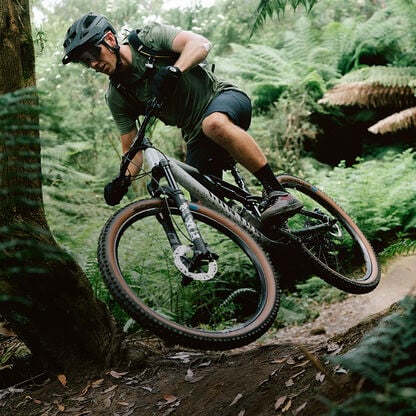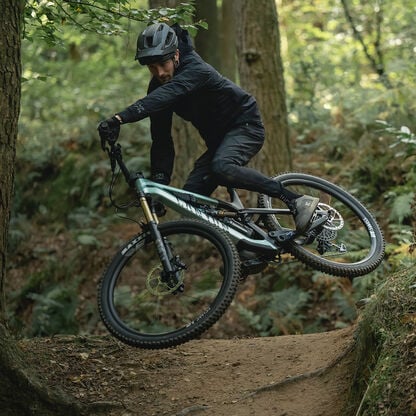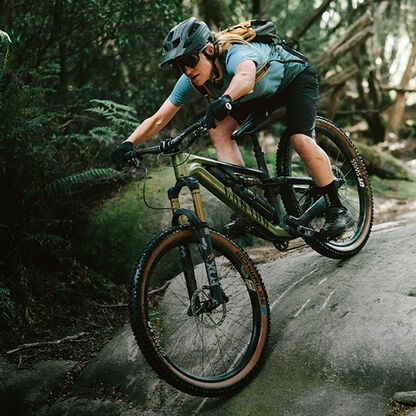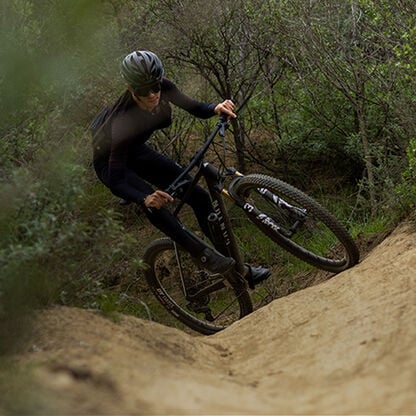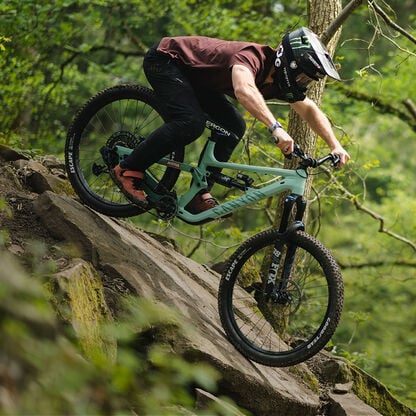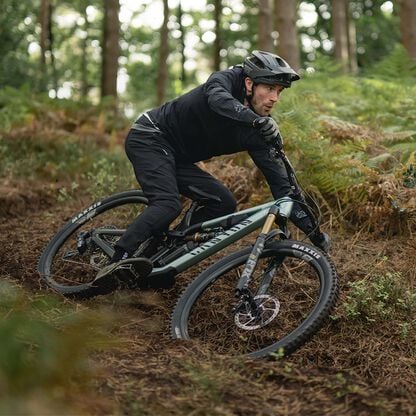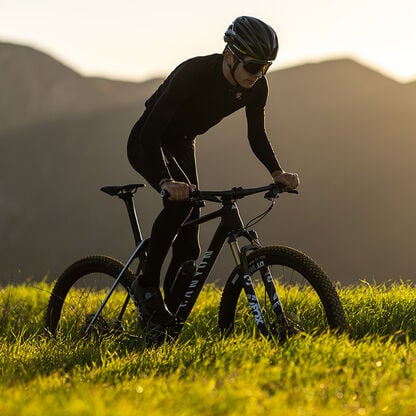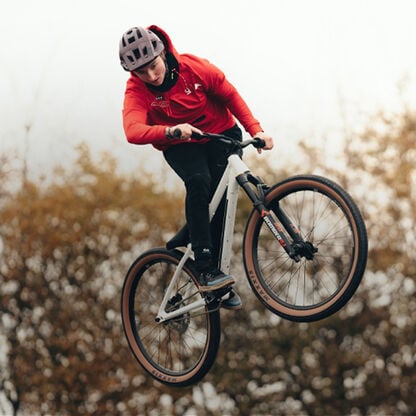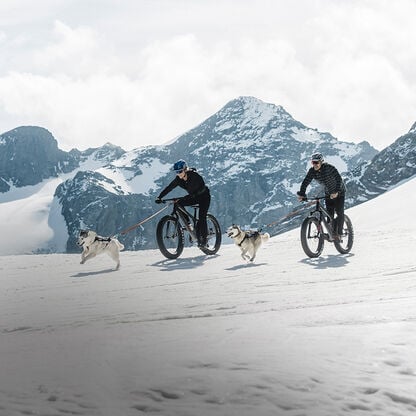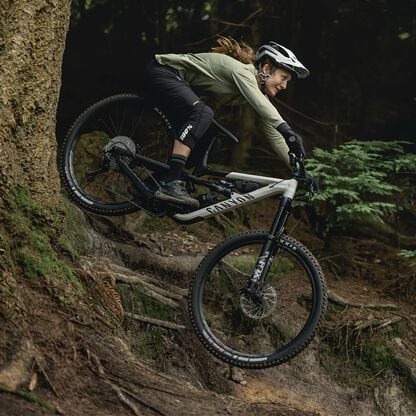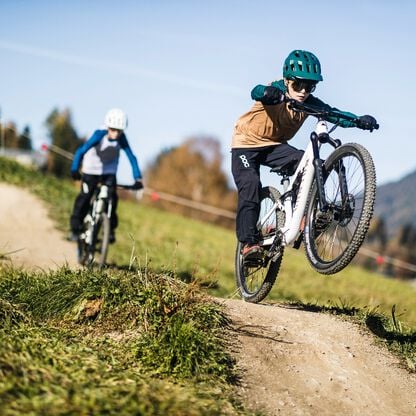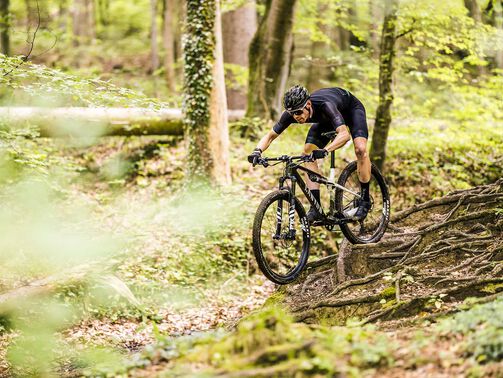How to choose the best mountain bike: Your ultimate buying guide
Explore the different types of mountain bike on offer so you can make the best-informed buying decision.

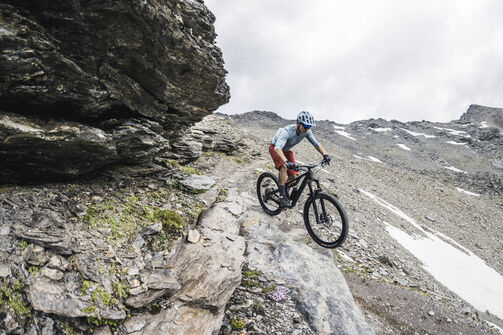
Mountain bikes are awesome. You’re awesome. Naturally, the two should get together ASAP. In this buying guide we’re gonna go deep on the different types of mountain bikes, so you can make an informed decision about which style is best for you.
We’ll also give you some other tips on how to choose a mountain bike, based on things like their components and the materials they’re made from. We’ll answer some common and not-so-common questions — and put you in the driving seat when it comes to buying your next awesome MTB.
Contents
What is a mountain bike?
This question is a great one to start with. A mountain bike is basically something with two wheels that has been designed for serious off-road riding, particularly the kind of terrain that goes beyond gravel.
A good mountain bike is highly capable. That means big tyres with loads of grip, and almost always some form of suspension system. We’ll get into the different kinds of MTB suspension a little bit later on - but for now it’s enough to know there are full-suspension MTBs (with a suspension front fork and rear shock) and hardtail (with just a suspension front fork).
Mountain bikes also have wide, flat handlebars giving the rider maximum control as they navigate obstacles on the trail.
And then there’s geometry. When we use the term geometry in a bike context, we mean the angles and lengths of the frame and some of the other parts. A bike’s geometry has a big effect on how it feels to ride.
There’s a whole heap of different sub-categories within mountain biking. And each is best approached with a slightly different geometry. Generally though, mountain bike geometry is a careful balance between agility and stability, tailored to the bike’s intended use - whether cross-country, trail, enduro, or downhill.
Why choose a mountain bike?
Mountain biking offers a strong sense of adventure and variety, with constantly changing terrain, natural obstacles and technical challenges to keep you engaged. Trails often wind through forests, mountains, and remote areas, creating a deep connection with nature and a feeling of freedom.
There’s also an argument that in MTB, the varied riding positions and dynamic movement can be more forgiving on the body than other styles of cycling. The need to focus entirely on the path of your wheel in front of you can also add a rewarding mental aspect.
For many mountain bikers, it’s the combination of challenge, scenery, and immersion that makes choosing a mountain bike such a fulfilling decision.
Types of mountain bikes
With so many mountain bike styles out there, choosing the right one depends on how and where you ride. From flowing singletrack to steep descents, each MTB is designed with a specific kind of trail experience in mind. Here’s a breakdown of the most common mountain bike types to help you find your perfect match.

Trail bikes: your all-rounder for rough terrain
Trail bikes are an extremely popular choice, and with good reason. They are great do-it-all bikes for anything from your backyard trails to mountain adventures. These bikes serve one purpose: maximising fun on the trails, both for beginners and veterans alike.
At Canyon, both our best-selling Neuron with 130 mm rear travel and the Spectral with 150-160 mm travel belong to this category.
Their forgiving geometry and handling help you continually improve your riding skills, whether you’re flying down flowy trails or taking on technical sections. And they don’t leave you hanging when it’s time to tackle the next uphill section either.
Enduro bikes: optimised for long rides and steep drops
Take a wide variety of ride styles from extended tours to bike park trail shredding, add a healthy dose of racing performance and some extra durability: that’s how you make an enduro bike.
These all-rounders lean towards the downhill side of things and are packed with components that you can rely on when the going gets rough. You should be looking for generous 160-170 mm suspension travel and big wheels with burly tyres.
However, all that capability comes at the price of added weight. That means you might not be the first up the hill on an enduro bike but thanks to modern geometries, you still won’t have to wait for a shuttle.
When it comes to choosing an enduro bike, look out for a slack head angle, long reach, and steep seat tube angle for the best riding experience uphill.
We make two enduro bikes at Canyon, the Strive and the Torque. The Strive is race ready. It’s a fast and dynamic teammate that supports your uphill sections and keeps you steady and rapid on descents with two modes that subtly alter its geometry on the fly. It’s made for the task and the bike chosen by our competitors on the Enduro World Series.
The Torque, meanwhile, is an incredibly versatile platform — which is why you’ll find it in this section and the one below about downhill bikes. It’s designed for stability and strength, taking every jump and landing like the burly boss it is while giving you the traction you need on those techy climbs. It really is that capable
Downhill bikes: built to dominate the descent
Some bikes let you take on even the most daunting descents. These bikes are ready for the steepest cliffs and their suspension can easily eat up the gnarliest roots. We’re talking, of course, about downhill bikes.
When choosing a downhill bike — which are sometimes also called freeride bikes — you want to be looking at 180–200 mm suspension travel front and back, and with geometry that is fully optimised for high-speed descents.
This requires an extremely slack head angle combined with a long reach and wheelbase, while you’ll also want bombproof construction that can withstand even the biggest hits.
The Canyon Sender is our quintessential downhill bike. Since these bikes specialise exclusively in downhill riding, riders tend to rely on lifts or shuttles for the way up.
Our versatile Torque with its 170 mm travel is the exception to that rule: freeride bike, super-enduro, park bike — call it what you will, this bike won’t fit into any neat categories.
It’s just as good for enduro tours as it is for long days on the jump line at the bike park. You can even climb your own hills on it, though you won’t be taking any KOMs.
All in all, downhill bikes are almost as versatile as trail bikes or enduro bikes, albeit with a greater focus on all-action descents.
Cross-country bikes: optimised for long distances and speed
With their low weight and race-ready specs, cross-country bikes are optimised for efficiency and speed. These are the bikes that toe the line at the Olympics or World Cup races from Albstadt to South Africa, as well as your local marathons.
They’re all about lightness and durability — and they’re the perfect choice if you like riding longer distances on a variety of terrains. Up, down, on the flat — cross-country bikes can do it all.
If you’re looking for a competitive level cross-country (or XC as it’s sometimes abbreviated) bike, the frames are nearly always made from high-grade carbon fibre to minimise weight and maximise performance. Rolling on carbon fibre wheels too, these bikes are lightweight racing machines.
In terms of suspension, XC hardtails tend to have 100 mm front travel (and the same in the rear on full-suspension models). Canyon offers both an XC hardtail, the Exceed, as well as an XC full-suspension bike, the Lux.
If you’ll mainly be keeping to beginner trails without too much technical challenge but still enjoy bopping along at speed, the Exceed is the perfect bike for you. If you like your rides with a little more gnar, opt for the Lux.

Dirt jump / street bikes: for dirt, air, and everything in between
This family of bikes is all about freestyle and self-expression. They’re built for sessions on the pump track, taking off jumps or riding on the street.
When choosing a dirt jump or street bike, the key features are agility and durability. They need to be made of stern stuff to withstand all the impacts you’ll subject them to, and handle nimbly so you can push yourself to pull off bigger and bigger tricks.
We make two bikes in this category, which share a name.
The Stitched CFR Trial is born for trials riding. It’s incredibly tough but handles like a dream. The frame is made with carbon fibre for extra weight reduction.
Its sibling is the Stitched 360, which differs in a couple of ways. It’s built more for pump track and dirt jumping, is made with an aluminium frame, and it deploys a front suspension fork with 100 mm of travel to take the hit out of some of biggest drops and impacts.
Youth MTBs: lightweight, tough, and ready for the trails
When it comes to buying a youth MTB bike we have one big bit of advice. Make sure you buy a bike built for young people, not an adult bike shrunk down or a hastily thrown together collection of smaller-sized parts.
A little bit of dedication goes a long way, and we really believe that designing specifically for youth riders pays big dividends. Our goal is always to imbue the youth MTBs with the same properties of their adult equivalents.
For young people into trails, there’s the Neuron Young Hero, and for cross-country riders there’s the Lux World Cup Young Hero. Both these bikes are inspired by performance models used by our elite athletes, with the Lux frequently seen on the top UCI MTB World Series podium.
If they’re more into riding hardtails, consider the Exceed Young Hero or the Grand Canyon Young Hero. Both of these bikes bring the magic of MTB to life for smaller, lighter riders — and will set them up well for a life lived on the trails.
E-MTB: your extra power for tough climbs and thrilling descents
When looking for an electric mountain bike the biggest extra thing to think about is the motor and battery system.
Naturally, a lot of what we’ve written above still applies here. Your e-MTB needs to match the style of off-road riding you want to do.
If you want an electric hardtail mountain bike for exploration, it still needs to be light, fast and efficient like a conventional hardtail, but you’ll also want an e-system with a nice long range to support you all the way home. In this case, the Grand Canyon:ON is a real winner.
Likewise, an electric enduro bike must still feel fast and nimble on the descents, but it also needs a lot of torque to help you blast along the uphill sections. The Strive:ON is the perfect solution, with up to 340% pedal assist and a staggering 600 watts of peak power.
Canyon mountain bike models: pick the exact right one for you
Decided which mountain bike type is right for you? Now it’s time to pick which exact model you need! Luckily, at Canyon we’ve got a logical naming system that makes it easier.
If you’ve browsed through a couple of our bikes, you’ll have seen that a typical Canyon bike name might read something like ‘Torque DH CLLCTV’ or ‘Spectral 5’.
This is what it all means.
What does the number in the name of Canyon mountain bikes mean?
In short, the higher the number in the name, the more premium the components.
It’s important to remember that even on our most affordable bikes, the standard of modern bike components is very high in terms of reliability and durability. So, even on a Spectral 5, you could ride across entire continents or around the entire globe (as long as you keep your bike well maintained and looked after).
However, on the higher-number bikes, the higher-quality components are significantly lighter, and feel more premium and more comfortable, which makes a major difference the longer you spend in the saddle.
Example of upgrades you’ll see at higher levels include things like electronic gear shifting, carbon wheels, more premium tyres — all feel awesome and we can promise that upgrading to parts like these gives you a major boost in terms of speed and comfort.
BUT: functionally, remember it’s nothing you absolutely need to take on epic rides and love them.
What do CFR/CF AL mean?
In most cases, this refers to the frame material — CFR bikes are top of the pack, using the world’s best carbon while CF uses high-quality carbon fibre too, just not quite that top tier stuff. Of course, we tend to fit a higher spec component onto the higher-end models.
| Type | Description |
|---|---|
| CFR | The choice of the pros: if a bike has CFR in the name, you know it’s the best of the best we can build. Raced by our pros, constructed from the highest grades of carbon fibre, and built out with the finest parts available on the market today. |
| CF | Carbon for all: CF bikes take all our design mastery and carbon fibre expertise and make it available in our most accessible carbon bikes. These bikes typically feature the same frame dimensions as the high-end CFR models, with slightly less advanced carbon, and medium-class components. |
| AL | Aluminium bikes - affordable, durable: If the bike name doesn’t have any of those in it, or has the letters ‘AL’ in its name, then it’s made from aluminium. Aluminium bikes are typically the most affordable in a bike range. While lacking the prestige, elegance and lightness of their carbon counterparts, they’re more resistant to mechanical mishaps and deal better with being dropped and exposed to rougher handling. |
| :ON and :ONfly | :ON identifies our electric bikes, helping distinguish them from conventional models within the same family (e.g. Neuron vs. Neuron:ON). :ONfly goes a step further, marking lightweight, agile e-bikes designed with minimal weight in mind. |
Canyon mountain bike titles: what else to know?
Sometimes, you’ll see a bike name with an extra word or phrase added on the end – examples like ‘CLLCTV’, ‘LTD’, or similar.
These words typically describe a standout feature or characteristic of the bike that makes it special. For example, LTD refers to a limited edition with an especially high-end spec or featuring special edition parts. CLLCTV is Canyon’s identity for its gravity-focused mountain bikes and community - covering disciplines like downhill, enduro, and freeride. Bikes like the Torque CLLCTV or Sender CLLCTV are built for aggressive performance and represent the bold, progressive spirit of Canyon’s MTB scene.
We recommend reading the short description on a bike’s product page for a clear idea of what the standout features of one of these bikes are.

What to look for when buying an MTB
Once you know what type of MTB you want to buy, the next step is understanding what makes a truly brilliant bike. There are a lot of moving parts to a bike, which it’s good to understand, not to mention things like frame material and sizing.
Best frame materials for mountain bikes
Two frame materials have all but cornered the market in the last few decades. Aluminium offers great durability at an excellent price point (check out our aluminium mountain bikes). The other prime contender is carbon: developments in carbon technology have unlocked new dimensions of stiffness, comfort, and weight, as well as a wider variety of shapes (discover our carbon mountain bikes).
What’s more, carbon frames can be reinforced in critical areas, while other parts can be made thinner to use less material and save valuable grams.
In terms of durability, aluminium and carbon are on equal footing: Nowadays, even cutting-edge downhill bikes like the Canyon Sender CFR use carbon frames — and they have everything it takes to hit the world’s toughest downhill courses.
Suspension types for MTB: hardtail vs full suspension
There are two general types of mountain bikes: hardtails, which only have suspension at the front, and full-suspension bikes, which have a rear shock as well as front suspension forks. Which of the two is right for you depends on the type of terrain you like to ride in, your ride style, and your budget.
Hardtail MTBs are generally more affordable and lighter than full-suspension bikes, as well as requiring less maintenance thanks to their simplicity — all of which makes them a great choice for beginners. They are also more efficient uphill, since they transform all your pedalling power directly into forward motion. And there is virtually no upper limit to their level of sophistication (orprice point). Carbon fibre hardtails are the elite choice for cross-country racing in terms of performance and weight.
It’s where a hardtail sacrifices comfort on rough terrain for efficiency that full-suspension mountain bikes really start to come into their own. Thanks to the rear shock, a full-suspension bike offers better traction over root sections and rocky trails.
This not only makes for better control on technical terrain, but also dials up the fun, since a full-suspension MTB is ultimately the faster bike when the going gets rough. But what about going uphill?
Most mountain bikes on the market have eliminated the squatting tendencies that once plagued them and won’t rock, even when you get out of the saddle and pump the pedals. In addition, many modern rear suspensions can be locked out via a lever, effectively turning them into a hardtail for longer climbs.
These bikes are packed with a lot of sophisticated technology and have more parts. This takes us to the two main downsides of full-suspension mountain bikes: they cost more money and are heavier than hardtails.
MTB wheels and tyres: what to look for
When choosing MTB wheels and tyres, durability, grip, and terrain compatibility are key. Wheel size — typically 27.5" or 29" — affects how the bike rolls over obstacles and handles tight corners. Larger 29" wheels roll more easily over anything in your path whereas the smaller 27.5” wheels are lighter and nimbler, making it easier to ride twisty trails. Wider rims offer better tyre support, especially for aggressive trail or downhill riding.
Tyres should match the intended terrain: chunkier tread patterns provide grip on loose or muddy trails, while lower-profile treads roll faster on hardpack.
In MTB, tubeless setups are popular for their puncture resistance and ability to run lower pressures for better traction.
MTB drivetrain and gearing explained
Modern mountain bikes usually feature a 1x drivetrain, which uses a single front chainring and a wide-range rear cassette to simplify shifting and reduce weight.
The gear range is crucial on an MTB — lower gears help with steep climbs, while higher gears allow for efficient pedalling on flats or descents. Components are built for durability, as off-road conditions can be tough on chains and derailleurs.
Clutch-equipped rear derailleurs help keep the chain stable over rough ground, and gear selection often prioritises smooth, reliable performance over speed.
You can dive deeper into MTB groupsets in our dedicated guide.
MTB weight and handling
Weight plays a huge role in how a mountain bike handles, especially on climbs and technical sections. You don’t want to be lugging extra kilograms up 15% punches if you don’t have to!
Frame material, wheelset, and suspension design all contribute to overall weight. And generally speaking, the more you spend the lighter things tend to get.
Handling is shaped by a bunch of factors, but chief among them is geometry (as we discussed up top). Then there’s the amount of suspension travel, and rider position.
Bikes with longer wheelbases and slacker head angles are more stable at speed, while shorter setups offer nimble, responsive control on twisty trails.

Must-have accessories for MTB riders
There are a bunch of MTB accessories that can improve your ride, as well as some that are designed to keep you safe. A good MTB helmet with extended coverage is super-important, often paired with gloves and protective eyewear.
Many riders use clipless or grippy flat pedals for better control. A multi-tool, spare tube or tubeless repair kit, mini pump or CO₂ inflator, and a water-carrying system like a hydration pack are all trail staples.
Lights and a bell are useful options — especially if you want to explore some night riding or use a lot of shared paths.
How to choose the right mountain bike size
If you’ve never ridden a mountain bike before, it can be tricky to figure out what size you might need.
Our handy Perfect Positioning System (PPS) will help you decide which size mountain bike you need to get the best fit. All you need to do is type in your height and your inner leg length measurements and we’ll do the rest. With over 15,000 data points, PPS provides a tailored size suggestion. We've found that 98% of people, when inputting correct data, will receive their ideal frame size using our tool.
Still not sure? Then go ahead and check out our mountain bike sizing guide for helpful tips and recommendations to make the right decision.
Mountain bike roundup
Choosing the best mountain bike for you is, ultimately, a personal choice. You know better than anyone what excites you about MTB.
Is it the chance to escape into nature that gets you hyped? You need a trail bike. Is it the ability to tackle challenging long-distance routes that most appeals? You should explore a cross-country MTB. Or do you want to fly down rooty and rocky descents at rapid pace? A downhill bike is your best bet.
It’s also important to bear your budget in mind. Often, what you’re able to spend plays a bigger part in the decision than any other single factor. We offer a range of accessible, entry-level MTBs which can serve as the perfect introduction to the sport.
And that's a wrap — enjoy the ride on your new Canyon dream bike! 🤙
Discover our Mountain Bikes
Did this article help?
Thank you for your feedback
